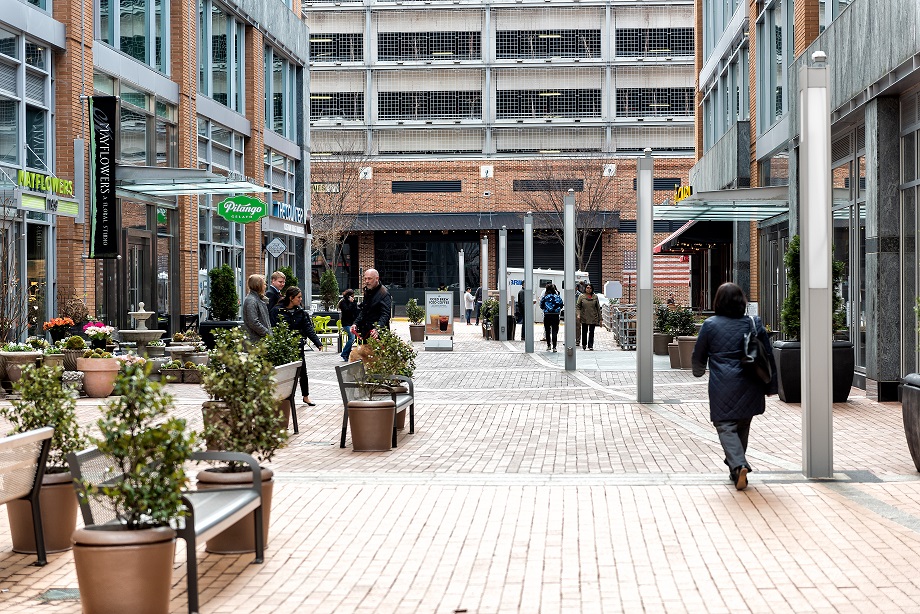Northern Virginia’s ‘Walkable Urban’ Development Creates a Model for the New American Dream
By
Frank Dillow

THE FUTURE OF THE AMERICAN DREAM may be hiding in plain sight right here in Northern Virginia.
The combination of the millennial generation and retiring baby boomers account for more than half of the American population, and they agree that their idea of living the American dream is found in new urban environments. Those spaces allow people to work, live and play within walkable distances.
Since 2010 when developers emerged from the Great Recession, Arlington County’s Rosslyn-Ballston corridor and Fairfax County’s Tysons redevelopment have been rapidly creating models for the future of Northern Virginia and of urban development across America.
This is the biggest sea change in residential and commercial development in the past 70 years – when the cardriven suburban sprawl began spreading across Northern Virginia as GIs returned home from World War II.
Since then, development has been based on drivable, not walkable, access. As decades rolled by, this reliance o cars and trucks put increasing cost and time burdens on commuters. Taxes climbed for property owners to finance the construction and maintenance of highways and to rebuild the largely abandoned and highly subsidized public transportation systems.
In a recent article entitled “Retrofitting Tysons from Edge City to Walkable Urban Place” in NAIOP’s (the commercial real estate development association) Development magazine, George Washington University Professor Christopher B. Leinberger, pointed out that the massive amount of construction currently underway at Tysons is transforming what was once a model for the drivable edge city into a “denser, more walkable urban place.”
Leinberger is also a partner in the Arcadia Land Company and a leading spokesman for the Urban Land Institute.
Leinberger noted that Tysons – located at the intersection of the Capital, Beltway (I-495), the Dulles Toll Road (Route 267), Leesburg Pike (Route 7) and Chain Bridge Road (Route 123) – has been the largest drivable edge city in the U.S. since the 1980s.
“Coming out of the Great Recession in 2010, Tysons had a total of 27 million square feet of office space, as well as 20 million square feet of retail, hotel and residential space, spread over 2,400 acres,” Leinberger said.
Tysons had become the 13th largest “downtown” in America, with more office space than cities such as Denver or Pittsburgh, supporting nearly 100,000 jobs with a population of only 17,000 residents, according to Leinberger.
By contrast, the transformation of Arlington County’s Rosslyn-Ballston corridor into a leading example of walkable urbanism was well underway by 2010. Its high-rise residential, office and retail development marched westward across Arlington County, surrounding the five Metro stations on the Orange Line from Rosslyn through Clarendon to Ballston.
Up until the recession, Tysons and the Rosslyn-Ballston corridor provided equally successful, albeit alternative, models for real estate development.
While both areas grew at a comparable pace, with similar absorption and rental rates, Leinberger noted that after 2010, Arlington County began to surpass Tysons in new construction as well as absorption. Its landlords enjoyed rental rates at about $10 per square foot more than Tysons. In residential development, the Rosslyn- Ballston corridor also added about 1,200 apartment units each year from 2010 to 2014 – more than three times as many as Tysons, which added only about 370 units per year.
In 2005, as transportation agencies were still drawing up their plans to extend Metro Service to Tysons, Fairfax County established the Tysons Land Use Task Force. Under the leadership of longtime resident Clark Tyler, the task force adopted plans to grow Tysons to 100,000 residents and 200,000 jobs by 2050.
Adopted by County Supervisors, the plan also recommended the area become more environmentally friendly with restored streams, a green network of parks, open spaces and trails. A more urban street grid was adopted to encourage pedestrians and bicyclists rather than just cars.
The plan recommended that Tysons would become more densely developed around the four Metro stops from McLean to Spring Hill, like The Boro development currently under construction. New housing would be built more densely in high-rise, multifamily units rather than,the more spread out and traditional singlefamily residential model. The plan’s vision for the future of Tysons is evident in the recent decision by developers to demolish,an existing 135,000-square-foot office,building built in 1983, which is located,nearly one mile from the nearest Metro,station. That building is being replaced with a 90-foot-tall building that houses 400 apartments, ground floor retail and an adjacent one-acre park.
With the emerging success of Tysons redevelopment, Fairfax County planners are looking to adopt similar development plans for Reston and perhaps other areas in the county. Arlington County also has encouraged the continued walkable urban transformation south from Rosslyn through Crystal City and Potomac Yards to Alexandria.
NVAR Realtors® will need to become comfortable with the denser urbanresidential model that is being driven by commercial development. This concept continues to spread throughout Northern Virginia and throughout the country – offering more housing options for today’s buyers.
Frank Dillow is a past chair of NVAR’s Realtor® Commercial Council, an NVAR instructor, and a senior commerical broker in Long & Foster‘s Commercial Division. He can be reached at francis.dillow@longandfoster.com.